In a shocking disclosure according to the WHO nearly 800,000 people commit suicide every year in the world, the second leading cause of death amongst people aged 15-29 in 2016,.
A toolkit to help communities prevent suicides was released by the World Health Organization (WHO) and the Mental Health Commission of Canada on the World Suicide Prevention Day
Suicides happen in all the countries and regions, whether rich or poor. However, most of them occur in low and middle-income countries, which accounted for almost four-fifths of the global suicides in 2016, the document said.

“Suicides take a high toll. Over 800,000 people die by suicide every year and it is the second leading cause of death in 15-29-year-olds,” it said.
There are indications that for each adult who dies of suicide there may be more than 20 others attempting suicide, it warned.
“The impact on families, friends and communities is devastating and far-reaching, even long after persons dear to them have taken their own lives,” the document said.
It is estimated that the method used for 20% of the global suicides is self-poisoning, most of which occur in rural agricultural areas in low- and middle-income countries.Other common methods of suicide are hanging and firearms, the UN agencies said.
In high-income countries, there is a well-established link between suicide and mental health issues such as depression and alcohol use disorders, but many suicides take place on an impulse during moments of crisis.
The toolkit outlines ways to prevent this serious public health problem, one of which is knowledge of the most commonly used methods and restrictions of access to these methods.
Other examples include policies to limit alcohol and drug abuse, effective mental health care, and follow-up care for attempted suicide cases.
The document explains that, as well as the health sector, many sectors of society need to be involved in preventing suicide, including education, labour, agriculture and the media. These actors all need to work together if they are to have an impact on this complex issue.
People commit suicide at all times of their lives, and each one, the report states, is a tragedy that affects families, communities and entire countries, and leaves behind long lasting effects.
In many countries, suicide remains a taboo subject, the report said, adding that this can prevent those who have attempted suicide from getting the help they need.
To date, only a few countries have included suicide prevention among their health priorities and only 38 countries report having a national suicide prevention strategy, it added.









